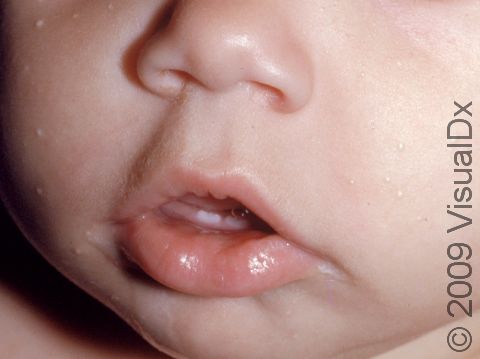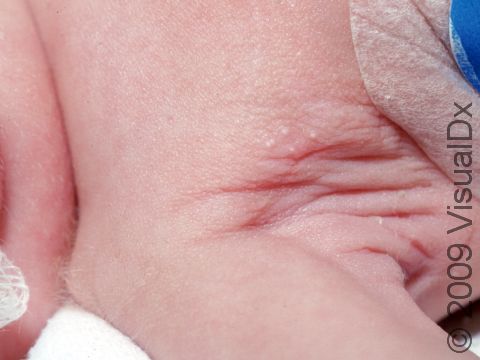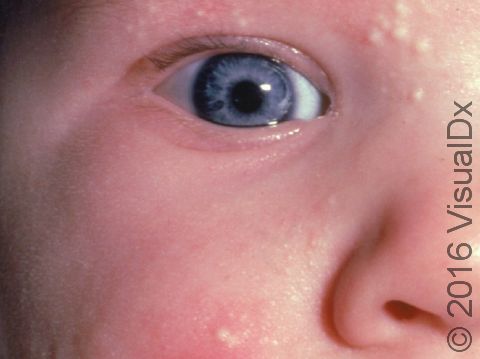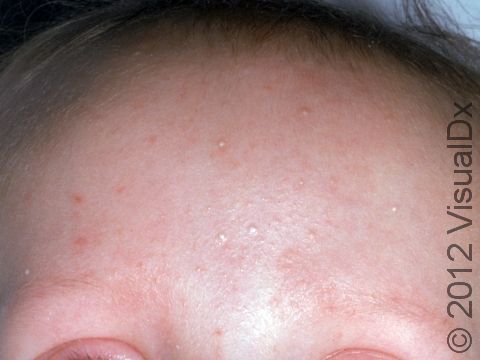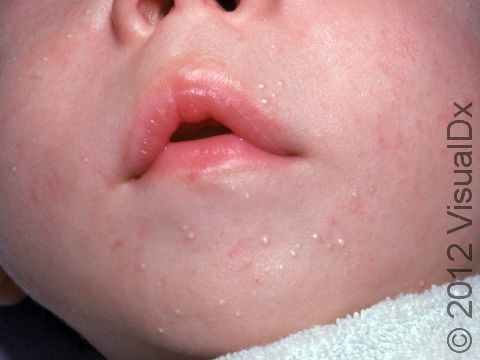Milia
Milia are tiny (1–2 mm) pearly white cysts on the surface of the skin that are common in people of all ages, but are more noticeable in infants since they are present on the face. Milia form because the oil gland in the infant is still developing, and the skin does not slough off normally but will instead remain trapped in a pocket in the skin. Milia are classified into 2 types: primary milia, which occur on normal, healthy skin; and secondary milia, which are typically found on skin affected by another skin condition. Milia that are found on the roof of the mouth in infants are called Epstein pearls and are normal in newborns.
Who's At Risk?
Milia can occur in all populations and ages. Primary milia are so common in newborns (occurring in up to 50%) that they are considered normal. Secondary milia are less common in infants but may appear if there is any injury to the skin.
Signs & Symptoms
The most common locations for primary milia in infants include:
- Around the nose
- Around the eye (periorbital area)
- Cheeks
- Chin
- Forehead
Very rarely, infants may develop milia in the following locations:
- Trunk
- Limbs
- Penis
- Mucous membranes such as inside the mouth
A milium appears as a small (1–2 mm), white to yellow, dome-shaped bump in the superficial skin.
Self-Care Guidelines
Although milia are found in the superficial layers of skin, they are difficult to remove without the proper tools. Trying to extract them at home is not a good idea as it may lead to scarring.
Primary milia found in infants tend to resolve on their own within several weeks, though they may persist for 2 or 3 months.
Treatments
If the doctor diagnoses primary milia in an infant, no treatment is necessary, as the condition will resolve on its own within a few weeks.
However, persistent and stubborn milia may occasionally be treated with the following:
- Topical retinoid cream such as tretinoin, tazarotene, or adapalene
- Removal with a sterile lancet or scalpel followed by use of a special tool (a comedone extractor)
Visit Urgency
Any new bump on your child’s skin should be evaluated by a dermatologist or by another physician.
Trusted Links
References
Bolognia, Jean L., ed. Dermatology, pp.1722-1723. New York: Mosby, 2003.
Freedberg, Irwin M., ed. Fitzpatrick’s Dermatology in General Medicine. 6th ed. pp.601, 604, 780. New York: McGraw-Hill, 2003.
Last modified on August 16th, 2022 at 2:45 pm

Not sure what to look for?
Try our new Rash and Skin Condition Finder
